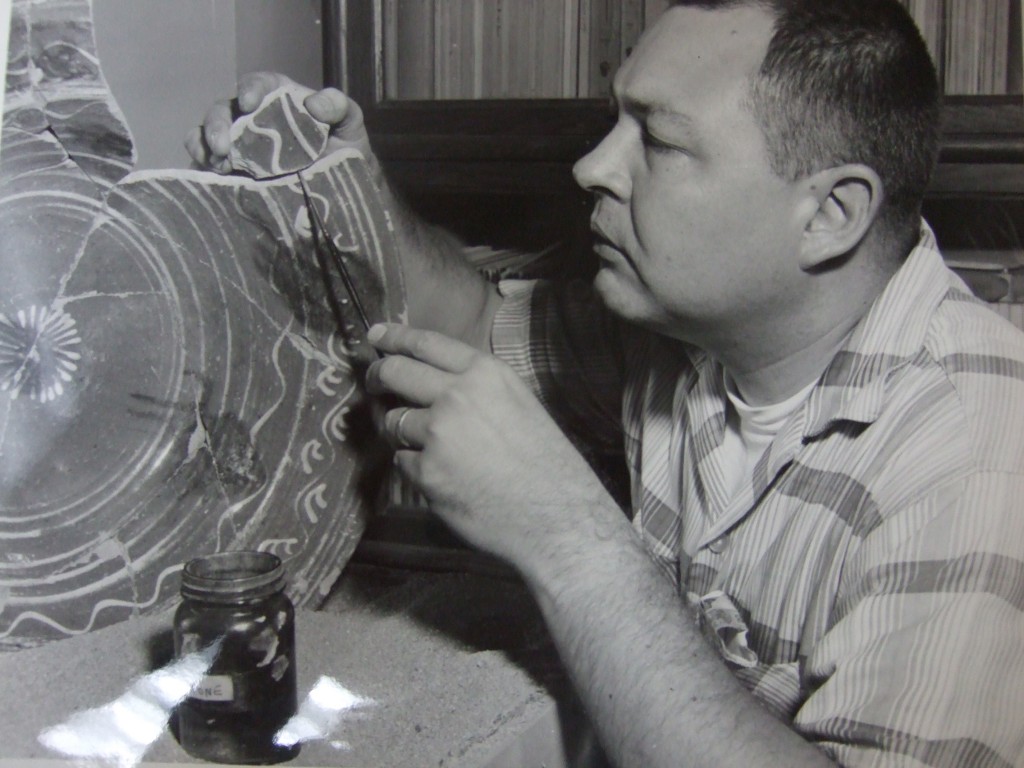History of Archaeology in Philly
Back to PAF Home
Back to Archaeological Research
IN BRIEF: THE HISTORY OF ARCHAEOLOGICAL RESEARCH IN PHILADELPHIA

National Park Service Archeologist Jackson Ward ‘Smokey’ Moore, Jr. conducted archaeological studies in Independence National Historical Park in the early 1960’s. (Photo courtesy of INHP Archives.)
The city of Philadelphia is home to many ‘firsts’ including the first hospital, the first library, and the first US university. This status as ‘first’ is true also for many areas of the field of archaeology. Americanist archaeology as a field of scholarship was begun in the 1780’s by members of the Philadelphia-based, American Philosophical Society (APS). In the early 20th century, some of the most important archaeological discoveries in the Near East and in Central and South America were carried out by researchers based at the University of Pennsylvania’s Museum of Archaeology and Anthropology, located in Philadelphia. Later, there were also important developments closer to home: The first urban archaeological site was excavated in Philadelphia between 1953-1955 (the site of Benjamin Franklin’s mansion), and, in the 1960s and 70’s the practice of historical archaeology was nurtured in excavations of Philadelphia neighborhoods, in Independence Park (located in Old City Philadelphia), and in the first program in Historical Archaeology (initiated at the University of Pennsylvania in Philadelphia).
Beyond Philadelphia’s archaeology contributing to the ‘history of American archaeology’s development’, archaeology in Philadelphia has contributed to the development of American history. The city’s diverse and dynamic manufacturing sector made Philadelphia the 19th century’s ‘workshop of the world’. Today, the city has a significant number of Industrial Archaeology sites that are of interest to Industrial Archaeology researchers. The archaeology of the region’s early Native population is both exciting and burgeoning. Recent discoveries (thousands of artifacts) have led to a reevaluation of the survivability for prehistoric evidence in urban settings. New understandings about Native American settlement are coming forth. The last decade in the city has also witnessed a flourishing of new archaeological research into the area’s early African American communities. This research has contributed both new data and new insights into the lives of 18th and 19th century African and African Americans –both those free and those enslaved. Historical archaeology research at Independence Park has also identified a possible Cold War site and cultural landscape in Independence Park that would be relevant for evaluation for the National Register of Historic Places’ Inventory of Cold War Resources, 1945-1989.
Of equal note for any survey of Philadelphia’s archeological history are the new archaeological technologies and methodologies developed or first tested as part of Philadelphia-based archaeological research. In the 1960’s, archaeologists at Independence National Historical Park first adopted and tested the use of ultrasonic cleaners and electrolysis baths for artifacts (technologies routinely found in archaeological labs around the world today). Also in the 1960’s the first surface tests of American-made proton magnetometers and other geospatial searching equipment were employed on historical archaeology sites in Independence Square (Old City, Philadelphia). Philadelphia archaeology has long been at the forefront of ‘public archaeology’ beginning with site tours during the Franklin’s house site excavation in the 1960’s, a public viewing platform at the First African Baptist Cemetery excavations in the 1980’s, a public lab (2004-2010) for the National Constitution Center site processing at Independence Park, and civic engagement at the President’s House Site and James Dexter house site excavations. More recently, Philadelphia archaeological sites and artifact collections are serving as the research medium for cutting edge computer science and Media Arts research. Drexel University computer scientists have been developing novel technologies for modeling artifacts and archaeological site interpretations in 3D (3 dimension), while Drexel Media Arts research is producing video and interactive animation platforms that the public can employ to engage with archaeological information.
+ A short description of the Archaeological Research Process
+ Types of Archaeological Reports
_ __
An Archaeological Research Reporting Overview…
Philadelphia Archaeological Research Report INDEX…
Philadelphia-area Archaeology Books…
Philadelphia-area Archaeology Articles/Papers…
by admin